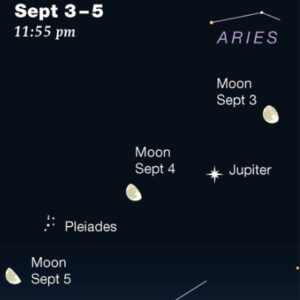Special to CosmicTribune.com, September 4, 2023
Excerpts from weekly Sky&Telescope report.
SUNDAY, SEPTEMBER 3
■ Jupiter’s four bright Galilean moons are roughly the size of our own Moon, but at 1,800 times the distance, they appear in a telescope as hardly more than pinpoints. Jupiter’s Great Red Spot should transit the planet’s central meridian tonight around 1 a.m. EDT.
MONDAY, SEPTEMBER 4
■ The waning gibbous Moon rises around 10 p.m. with Jupiter 6° or 7° to its right. They cross the sky together for the rest of the night.

TUESDAY, SEPTEMBER 5
■ As dusk turns to night, Arcturus twinkles due west. It’s getting lower every week.
WEDNESDAY, SEPTEMBER 6
■ Vega now passes the zenith right around the end of twilight, for those of us at mid-northern latitudes. Vega is bigger, hotter, and 50 times brighter than our Sun. But at a distance of 25 light-years, it’s 1.6 million times farther away.
■ Last-quarter Moon (exactly so at 6:21 p.m. EDT). It rises around 11 or midnight tonight, in eastern Taurus.
THURSDAY, SEPTEMBER 7
■ Herman’s Cross is now highest on the meridian in mid-evening. It lies more or less on its side and is about 1° by 2° in size. Its stars are all about magnitude 4½, making it a fine binocular target and visible to the naked eye in a moderately dark sky. It’s such a distinctive little thing that once you know it you’ll spot it often in photos of the Sagittarius Milky Way, demurely off to the east of the main attraction.
Two telescopic globular clusters, M75 and M55, lie a few degrees above and below it. They’re 9th and 7th magnitude, respectively.
FRIDAY, SEPTEMBER 8
■ With September well under way, the Great Square of Pegasus is high in the east after dark, balancing on one corner.
From the Great Square’s left corner extends a big line of three 2nd-magnitude stars, running to the lower left, that mark the head, backbone and leg of the constellation Andromeda. (The line of three includes the Square’s corner, her head.) Upper left from the foot of this line, you’ll find W-shaped Cassiopeia tilting up.
■ By 9 or 10 p.m. two of the best-known deep-sky objects are in high view in the area: the Double Cluster in Perseus (just below Cassiopeia), and the Great Andromeda Galaxy, M31. Did you know they’re only 22° apart?
The two clusters of the Double Cluster (NGC 869 and NGC 884) are at very similar distances about 7,600 light-years away. M31, at 2.5 million light-years, is about 330 times farther.
SATURDAY, SEPTEMBER 9
■ The waning crescent Moon rises around 3 a.m. Sunday morning the 10th, under Castor and Pollux. By early dawn they’re a vertical lineup high in the east as shown above.
SUNDAY, SEPTEMBER 10
■ With the evening sky moonless, this is a great week for the Milky Way under a dark sky. When Deneb crosses your zenith (two hours after Vega does, meaning around 10 or 11 p.m.), the Milky Way does too — running straight up from your southwest horizon and straight down to your northeast horizon.

You must be logged in to post a comment Login